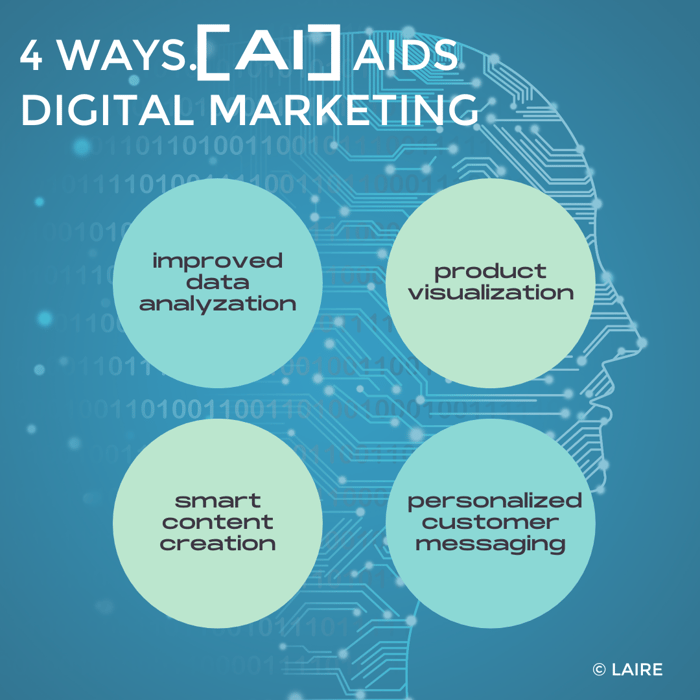Even years later, marketers, business owners, and companies can see that many of the shifts in consumer habits resulting from the pandemic are here to stay. What does this mean for today's digital brands?
In order to leverage these shifts, delight your customers, and reach your revenue growth goals this year, it helps to understand the current top trends in digital marketing. To offer some insight, check out these expectations to keep in mind for the rest of the year to come.
1. Google Chrome Phasing Out Third-Party Cookies
Many marketers recognize the big changes that are coming thanks to Google's announcement that it would end support of third-party cookies by late 2024 for those using the all-popular Chrome browser.
It's estimated that over 65% of all browser users rely on Chrome. That means a huge change for anyone who's relying on cookies as a component of their marketing campaign. This will create a significant change, but it's not the only concern.
Many advertisers use cookies as a way to understand how people use the web. Advertisers and businesses have long found tracking users like this beneficial — and even essential — when it comes to shaping their marketing plan and how they will overall reach people.
At the same time, most advertisers understand the concern on a personal level. Consumers are protective of their private information, and having computers tracking them doesn't seem right. Moreover, consumers are far more aware of their online privacy today than they used to be even just a few years ago. That has led to many opting out of third-party cookies and tracking already.
What will happen to digital marketing, then? In regards to cookie tracking, it's likely we can expect to see a number of significant shifts:
- Some advertisers are shifting to using first-party data to collect information about consumers.
- Zero-party data is also gaining attention. The consumer gives this data to the brand, often using gamification strategies, interactions with brands online, or surveys.
- It's also necessary to have robust CRM tools in place now before the cookies are depleted, so to speak, so that you can embrace data faster and sooner.
2. Voice and Visual Search Will Continue to Gain Popularity
A steadily increasing number of consumers regularly search online using popular voice-activated tools like Alexa and Siri. This technology quickly became the go-to for many consumers over the past few years as it became more easily accessible. In fact, around 35% of American adults have a voice-activated smart speaker.
But voice search isn’t the only search method rising in popularity — get ready for other creative alternatives, especially visual search.
Tools like Google Images and Google Lens allow users to search for whatever they can see using pictures, a game-changing technique for many. For marketers, this means a necessary shift to using more visual alt-text and sitemaps for images. In other words, high-quality visuals will become increasingly important for strong SEO results.
3. AI Continues to Shape the Digital Marketing Landscape

As artificial intelligence (AI) technology has become more accessible in the past few years, it has grown into an impossible-to-ignore topic for marketers and consumers alike.
Not only does the technology dramatically improve data analysis and trend prediction for marketers, but it can significantly improve the consumer experience as well. After all, we’re all guilty of adding something to our Amazon cart at the last minute after being presented with an AI-generated product suggestion.
Aside from telling us what to buy, AI can also create pretty darn good content for the web, social media, and more. In fact, it’s reported that 12% of businesses use AI chatbots like ChatGPT for content creation. (But don’t worry, content marketers — these bots aren’t coming for your jobs.)
Similarly, augmented (AR) and virtual reality (VR) are being incorporated into more and more mainstream marketing and sales tactics. For example, consumers can now imagine a piece of furniture to scale in their homes or upload a selfie to virtually try on a new lipstick before buying.
4. Influencer Marketing Is Here to Stay
Influencer marketing has continued to grow in prominence, with brands increasingly recognizing the power of social media influencers in reaching their target audiences.
The global influencer marketing platform industry is expected to reach $69.92 billion by 2029. This growth is driven by the increasing number of people using social media and the rise of micro-influencers, who have smaller but highly engaged followings.
One of the key reasons for the popularity of influencer marketing is the authenticity and trust that influencers can bring to a brand's message.
Consumers are more likely to trust recommendations from people they follow on social media than traditional advertising. In fact, 63% of consumers trust influencers more than brands, and 58% have made a purchase based on an influencer's recommendation.
As a result, brands are investing more in influencer marketing campaigns, with the average influencer marketing budget increasing nearly 16% from 2023 to 2024.
5. Investments in Online Events Are Still Worthwhile
The number of online events surged during the pandemic, stemming from a desire to connect with others but a need to do so in a safe manner. But even today, online events like seminars and webinars are well-loved — largely due to consumers’ desires to gather information about a topic, product, or service before taking an action or making a purchase.
These types of events don’t just benefit consumers though. They also offer businesses an excellent way to collect data that can be used for better marketing down the road. And this is especially important with the potential loss of third-party cookie data. Data aside, these online events also help to create stronger relationships between brands and their audiences.
Keep in mind that online events still require careful planning and execution. They don't always lead to a specific, heavy hit in revenue building, but they do create engagement opportunities and foster long-term relationships that all brands need heading into the next few years.
6. Look Beyond Social Media To Expand Your Audience
Today, many companies put a lot of their marketing energy into building a following on social media networks. That's valuable and can provide a solid return now, but it's going to be even more difficult to do in the future.
As of 2022, around 500 million tweets are posted each day — that's 350,000 tweets each minute. On the Facebook front, businesses that use the platform to send out ads have the potential to reach an audience of 1.98 billion people.
Considering these figures alone, it's hard to compete and stand out. The problem is even worse when you consider that your audience is likely following numerous brands.
What does this mean for your efforts in 2024? Put simply: It’s more important than ever to have direct ways to connect and communicate with your audience in an authentic manner. One way to do this is to create email newsletters.
Getting into your reader's inbox isn't always easy, but it provides a way for you to control who sees what you have to say, gauge interest, and compile more robust data. This tends to be more difficult with social media since you're competing with a large number of other businesses to get the small fraction of attention your audience has to offer.
7. Short Video Content Is Best
Consumer habits have changed a great deal over time, yet one thing remains the same: Consumers don't like to spend a lot of time on ads. Therefore, marketing strategies that involve video will need to keep those videos short and to the point — but still memorable.
There's still a place for long-form videos, but that type of content is more about telling stories and describing products than it is about capturing attention and engaging consumers.
8. Mobile Optimization Will Be Critically Important
Mobile devices have surpassed desktops as the primary means of accessing the internet. With this ever-increasing prominence, it’s crucial for marketers to ensure that their websites, ads, and other digital content are optimized for mobile devices.
Mobile optimization improves the user experience by making the content easy to read, navigate, and interact with on smaller screens.
Moreover, search engines like Google prioritize mobile-friendly websites, ranking them higher in the search engine results pages (SERPs). And higher ranking means more visibility, traffic, and potential leads and conversions.
Mobile optimization is also critical in targeting younger demographics such as millennials and Gen Z who are more likely to use mobile devices than any other group. In other words, if you want to reach and engage with your target audience, you must have a mobile-first approach.
9. Campaigns Must Be Created With Purpose
Today’s consumers can sniff out insincerity easily. And for brands, the need to connect authentically with audiences and practice transparency is more important than ever.
Consumers expect brands to “walk the walk” when it comes to their presented mission and values.
This has resulted in numerous impactful, philanthropic campaigns like Rare Beauty, which donates 1% of all sales to their Rare Impact Fund as well as raises additional funds to increase access to mental health services in all educational services, or Wildfire, which pledged to plant 20,000 trees in 2023 in order to offset the carbon emissions that the business is responsible for.
When it comes to initiating these campaigns, certain issues stand at the top of importance for consumers, namely sustainability and inclusivity.
A significant 81% of global respondents across gender lines and generations reported strongly believing that companies should help improve the environment. Consumers are intentionally seeking brands that minimize environmental impact in their materials, packaging, and processes, and it will be key for brands to show their enthusiasm this year and beyond.
Additionally, our reignited cultural shift toward inclusivity has impacted purchase behaviors greatly over the past few years. 41% of shoppers choose to shift away from brands that don’t reflect their views on diversity, and 29% are willing to switch brands completely if they don’t show enough diversity.
10. Many Small Brands Will Win Big Breaks
The increasing relevance of digital consumption has broken barriers for underdog brands looking to break into major markets. It’s become easier than ever for small brands to not only enter the industry but legitimately compete with larger brands for market share.
Digital presence and inventory allow smaller brands to experience fast growth, so be on the lookout for more and more relevant members in your industry ― especially since over 60% of consumers shop at small and local businesses.
Takeaways From the Top 2024 Digital Marketing Trends
Here are some tangible goals to set yourself up for success in 2024 and beyond.
Be Flexible
Brands must construct their marketing strategies with flexibility in mind and be forward-thinking (yet realistic) to successfully navigate the new landscape of consumption. The entirety of your marketing department should be prepared to switch courses on a whim if necessary and always be willing to adapt new strategies in an ever-changing landscape.
Simplify Your Data Source
The increasing relevance of e-commerce and digital consumption comes with an influx of raw data related to channel traffic and purchase behavior. Take advantage of your increased collection of first-party data to inform advanced strategies and reach new customers.
Be Transparent
Your consumers want to know everything that goes on within your brand, so present it genuinely ― especially if you’re taking on initiatives with positive missions. When it comes to your brand’s values and missions, it doesn’t suffice to simply say “This is who we are.” You’ve got to show it to your audience.
Prioritize Customer Experience
After 2020’s impact on streamlined purchasing through online platforms, it’s going to be crucial for brands to evolve and make consumption as easy as ever, providing a genuinely pleasant experience for customers.
Find the Right Partner to Create the Results You Desire
Trends come and go, but one thing remains constant: You don’t have to juggle your marketing strategy and execution alone.
At LAIRE, our goal is to provide you with the right tools to grow new revenue using digital marketing. If you want to learn more about how we can help you leverage this year’s top trends and build a bright future for decades to come, it starts with a simple conversation. Contact us now to get started.



